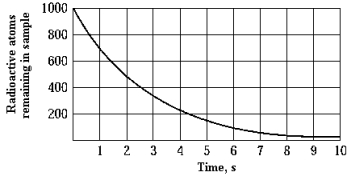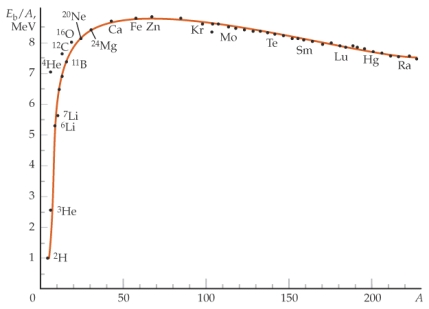A) 1500 counts/s.
B) 750 counts/s.
C) 375 counts/s.
D) 188 counts/s.
E) 94 counts/s.
G) A) and D)
Correct Answer

verified
Correct Answer
verified
Multiple Choice
At a particular time, a radioactive source A has a decay rate of 1.60 × 1011 Bq and a half-life of 15.0 d, and a second source B has a decay rate of 8.50 × 1011 Bq. Sources A and B have the same decay rate 45.0 d later. The half-life of B is
A) 0.19 d.
B) 8.3 d.
C) 2.8 d.
D) 5.4 d.
E) 28 d.
G) B) and E)
Correct Answer

verified
Correct Answer
verified
Multiple Choice
 A fusion reaction that is highly probable is
A fusion reaction that is highly probable is  The amount of fusion energy released in this reaction is approximately
The amount of fusion energy released in this reaction is approximately
A) 1.0 MeV.
B) 2.0 MeV.
C) 3.0 MeV.
D) 4.0 MeV.
E) 5.0 MeV.
G) C) and D)
Correct Answer

verified
Correct Answer
verified
Multiple Choice
In positron emission tomography PET) scans, a very small amount of a radioactive drug is given to a patient. Fluorine-18 doped or labeled fluorodeoxyglucose, also called FDG, is a radioactive version of the sugar glucose with a half-life of 110 minutes. Once injected into the body, it will go to places where glucose is used for energy. For example, FDG will go to the brain, and, in particular, to those parts of the brain that are actively burning glucose for energy. A variety of different images are observed depending on the parts of the brain being used in certain tasks, such as reading or listening. If the patient came back at the same time the next day after their initial injection for a further scan, how much of the original fluorine-18 decay rate would remain?
A) zero
B) 1.15 × 10-2 %
C) 3.53 × 10-2 %
D) 5.41 × 10-2 %
E) 5.41 × 10-4 %
G) None of the above
Correct Answer

verified
Correct Answer
verified
Multiple Choice
The half-life of phosphorus-32 is 14.3 d. If you have 1.00 g of phosphorous-32 today, the amount remaining in 10 d will be approximately
A) 700 mg.
B) 650 mg.
C) 616 mg.
D) 384 mg.
E) 350 mg.
G) C) and E)
Correct Answer

verified
Correct Answer
verified
Multiple Choice
Madame Curie is famous for the discovery of radium and her pioneering work on radioactivity. The half-life of radium molar weight = 226g) is 1600 years. What is the decay rate in curies) of 5.0g of radium?
A) 4.95 Ci
B) 1.83 × 1011 Ci
C) 0.512 Ci
D) 52.3 Ci
E) 3.59 × 1011 Ci
G) A) and E)
Correct Answer

verified
Correct Answer
verified
Multiple Choice
Which of the following radioactive decay products has the largest electric charge?
A) alpha particles
B) beta particles
C) gamma rays
D) neutrons
E) All of these have the same charge.
G) A) and E)
Correct Answer

verified
Correct Answer
verified
Multiple Choice
Radon 222Rn is a radioactive gas produced as part of the natural decay chain of uranium. Because it is a gas, it can pose a health problem through inhalation, especially when high concentrations accumulate in homes. Suppose 5 × 108 radon atoms are present in a basement at some time. If the basement is sealed and left, then how many radon atoms remain after a month 31 days) ? The half-life of 222Rn is 3.82 days.)
A) 1.81 × 106
B) 1.49 × 105
C) 1.23 × 106
D) 6.16 × 107
E) None of these is correct.
G) A) and E)
Correct Answer

verified
Correct Answer
verified
Multiple Choice
The radius of the 64Ni nucleus is approximately
A) 1.2 fm.
B) 2.4 fm.
C) 4.8 fm.
D) 16 fm.
E) 64 fm.
G) A) and C)
Correct Answer

verified
Correct Answer
verified
Multiple Choice
Atoms of an element that have different atomic masses are called
A) ions.
B) isobars.
C) isotopes.
D) metastable.
E) dielectrics.
G) D) and E)
Correct Answer

verified
Correct Answer
verified
Multiple Choice
 The graph shows the number of undecayed atoms as a function of time. The half-life of this radioactive element is approximately
The graph shows the number of undecayed atoms as a function of time. The half-life of this radioactive element is approximately
A) 1 s.
B) 2 s.
C) 10 s.
D) 4 s.
E) 5 s.
G) A) and C)
Correct Answer

verified
Correct Answer
verified
Multiple Choice
 Two nuclides that are isotopes could lie on curve
Two nuclides that are isotopes could lie on curve
A) 1.
B) 2.
C) 3.
D) 4.
E) 5.
G) A) and C)
Correct Answer

verified
Correct Answer
verified
Multiple Choice
For most nuclei, the total binding energy is proportional to the number of nucleons. This leads to the conclusion that nuclear forces show the property of
A) pairing.
B) charge dependence.
C) relativity.
D) magnetism.
E) None of these is correct.
G) A) and B)
Correct Answer

verified
Correct Answer
verified
Multiple Choice
The nuclear radius of  is approximately
is approximately
A) 1.05 fm.
B) 3.60 fm.
C) 0.350 fm.
D) 11.2 fm.
E) 1.85 fm.
G) B) and E)
Correct Answer

verified
Correct Answer
verified
Multiple Choice
The alpha particles from a naturally radioactive decay have a kinetic energy of 4.25 MeV. How close does an alpha particle come within a gold nucleus if the particle is heading directly toward the nucleus? Give your answer in terms of number of radii of the gold atom, r = 7.0 fm.
A) 2
B) 8
C) 12
D) 15
E) 19
G) B) and D)
Correct Answer

verified
Correct Answer
verified
Multiple Choice
The half-life of a radioactive substance is 5 min. Which of the following statements is true of the decay of this substance?
A) After 10 min, one-fourth of the original substance remains.
B) The amount of the substance remaining after a given time is proportional to the number of minutes.
C) The amount of the substance remaining after a given time is inversely proportional to the number of minutes.
D) After 10 min, none of the original substance remains unchanged.
E) None of these is correct.
G) B) and E)
Correct Answer

verified
Correct Answer
verified
Multiple Choice
A radioactive nucleus with Z = 92 and A = 235 decays through a series of alpha, beta, and gamma emissions to a stable nucleus with Z = 82 and A = 207. The number of alpha particles and the number of beta particles emitted during the entire process are
A) 8 alpha particles and 6 beta particles.
B) 7 alpha particles and 4 beta particles.
C) 7 alpha particles and 10 beta particles.
D) 14 alpha particles and 7 beta particles.
E) None of these is correct.
G) None of the above
Correct Answer

verified
Correct Answer
verified
Multiple Choice
 After a star fuses most its hydrogen into helium, it begins to fuse the helium into carbon. The energy released in fusing helium nuclei α particles) into carbon is approximately
After a star fuses most its hydrogen into helium, it begins to fuse the helium into carbon. The energy released in fusing helium nuclei α particles) into carbon is approximately
A) 0.730 MeV.
B) 1.46 MeV.
C) 7.30 MeV.
D) 14.6 MeV.
E) 73.0 MeV.
G) B) and E)
Correct Answer

verified
Correct Answer
verified
Multiple Choice
One way to think about the low binding energy Eb) per nucleon for low A numbers is 
A) that there are few protons, hence there is less electrostatic repulsion.
B) that there are few electrons to provide the electrostatic attraction.
C) at low A the number of nearest neighbors per nucleon is small compared to higher A numbers.
D) at low A, the nucleus is less spherical, hence there is less surface tension.
E) None of the above statements is correct.
G) B) and E)
Correct Answer

verified
Correct Answer
verified
Multiple Choice
In what type of radioactive decay are the mass numbers of the parent and daughter nuclei the same?
A) alpha
B) beta
C) gamma
D) both alpha and beta
E) both beta and gamma
G) A) and E)
Correct Answer

verified
Correct Answer
verified
Showing 41 - 60 of 94
Related Exams